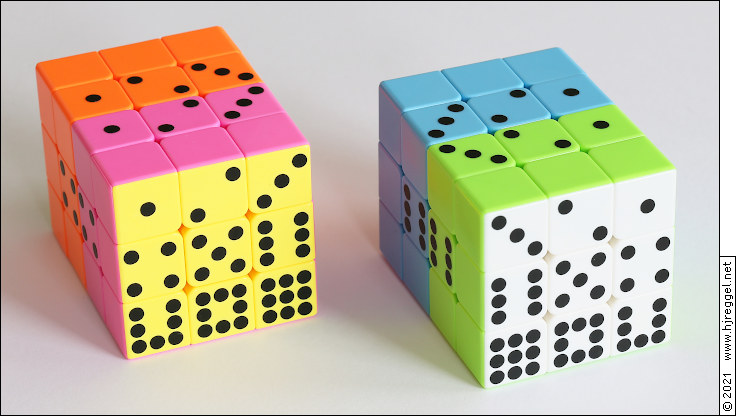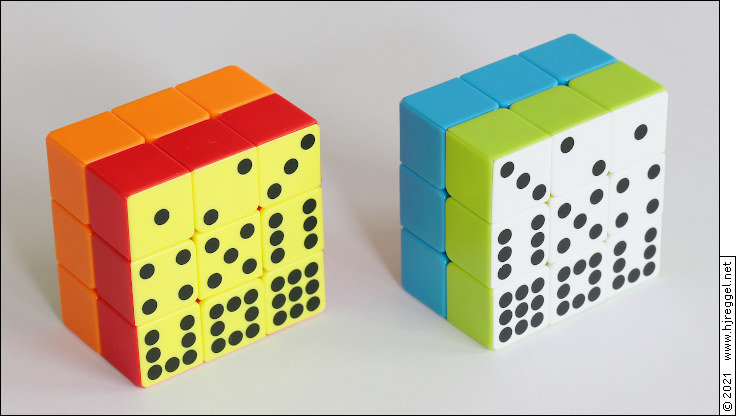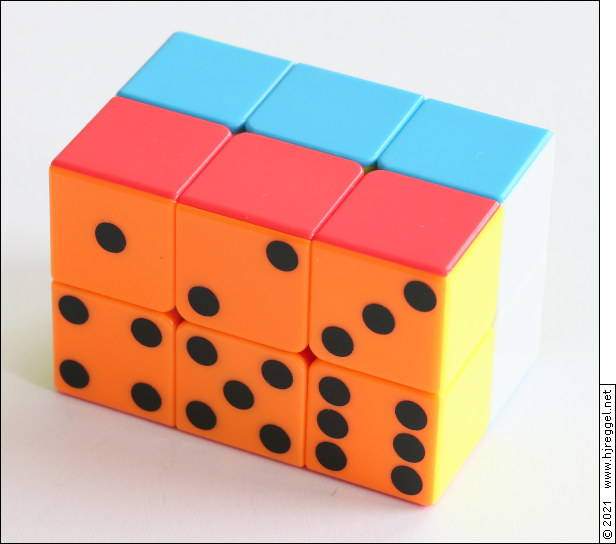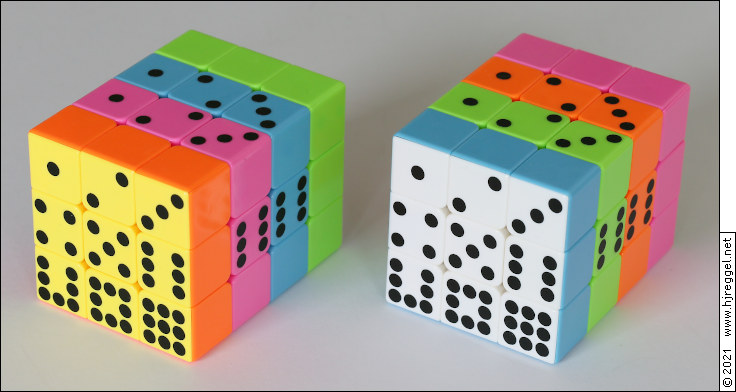 | |
| Fire + Ice 3×3×4 Domino | |
funCUBING Index Page · funCUBING Projects · The Domino Project
While thinking about possible Domino Projects, I realized that it is almost impossible to get black and white bodied twisty puzzles. Nowadays everybody wants stickerless puzzles, and most of the new releases only come as black stickered version.
Because I wanted to create a 3×3×4 Domino, I made up my mind how the Domino Principle could be applied to a single-colored body. But what about all those stickerless puzzles?
The Domino Principle tells that color should be the indicator between the leading and the opposite face. First, any two colors would do. But it's only important to indicate clearly, to which half a cubie belongs. On a 3×3×4 cuboid, the 3×3 faces are of one kind, and the 3×4 faces of another kind. That means you can only mix top and bottom face colors, or colors within the side faces. Within the side faces, you can only combine parts from outer rings, or parts from inner rings. Although each cuboid has twelve cubie faces of each color around, you need two cuboids to get rings of single color.
 | |
| Fire + Ice 3×3×4 Domino | |
For the first build, I decided to pick up the "Fire & Ice" theme, where the "warm" colors yellow, red and orange belong to the "Fire" group, and the "cold" colors white, blue and green to the "Ice" group.
The sub-cubie parts of two stickerless cuboids are assembled in such a way that one cuboid gets all of the warm colors, while the other one gets all the cold colors. The parts of the 4×3 faces have to be assembled to create rings of uniform color, the 3×3 faces get the same color on each cuboid.
Having both 3×3 faces of a 3×3×4 cuboid of the same color leaves two orientations for the "core". However, this does not create parity issues as with the 3×3×3 void cube. There are only a few operations needed to swap top and bottom center on a 3×3×even cuboid.
The photo shows a 3×3×4 "Fire" Domino with leading pink side, and a
3×3×4 "Ice" Domino with leading blue side viewed from the opposite (green) side.
 | |
| Fire + Ice 3×3×2 Domino | |
I liked the look of the Fire + Ice 3×3×4 Dominos, and I had 3×3×2 for other projects available. Therefore, I decided to postopone the other projects, and use the stickerless 3×3×2 cuboids to create Fire + Ice 3×3×2 Dominos.
The same notes as for the Fire + Ice 3×3×4 appl here, too. Swapping two centers is the same procedure, you just turn single layers instead of double layers.
Although the 3×3×4 and 3×3×2 are from the same manufacturer, the "Fire" tones differ.
 | |
| Fire & Ice 3×2×2 Domino | |
A single stickerless 2×2×3 cuboid can easily be turned into a "Fire & Ice" 3×2×2 Domino. This means re-arranging the colors in such a way that an equal colored 3×2 face has the matching theme colors around. This splits the cuboid in two 3×2×1 halves, where the warm and cold colors are separated. The "Fire" half has yellow on the short sides, the "Ice" half has white on the short sides. The other two pairs of colors can be distrubuted by personal preference. If you take contrast into account, orange and green have better contrast for the black dots, while red and blue have better contrast against each others on the side faces.
This is a good example that you should not mess with the orientation of a cuboid:
The puzzle looks nice, but the visual appearance does not correspond to the
orientation during the solve.
First, the middle 2×2 layer is solved like a 2×2×1 floppy cube. Then the eight corners of the
opposite 2×2 layers are solved exactly like the corners of an original Rubik's Domino.
Well, except that there are no domino dots on the 2×2 faces.
 | |
| 3×3×4 Rainbow Dominos; Left: Leading Yellow Face, Right: Leading White Face | |
As an alternative layout for the Fire + Ice 3×3×4 Dominos, the colors can also be alternated. For a more intuitive layout, the warm and cold colors have been kept together. These two Dominos are an example that it is only important to mark to which half the cubies belong.
The benefit of the Rainbow layout is that it allows yellow and white on opposite 3×3 faces. Like this, the orientation of the core is indicated clearly.
It is not important to know or guess the order of the ring colors. If you bring a cubie of one of the inner layers to the opposite half, the cubie changes its orientation. Then you will not be able to match it with the outer layer. For example, if you bring the blue number three cubie to the layer towards the yellow/orange ring, you could place it below the number three cubie, but the number would appear next to number six instead of next to number two. The same would happen to the other three inner corner cubies one, seven and nine.
Funcubing Index Page · Projects · The Domino Project · Top of Page